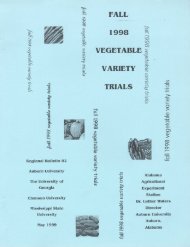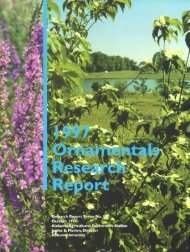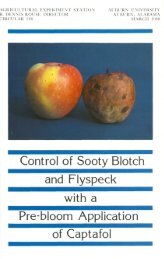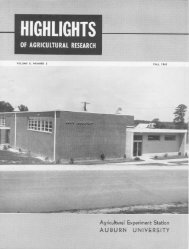MARKETING CHRISTMAS TREES - Auburn University Repository
MARKETING CHRISTMAS TREES - Auburn University Repository
MARKETING CHRISTMAS TREES - Auburn University Repository
You also want an ePaper? Increase the reach of your titles
YUMPU automatically turns print PDFs into web optimized ePapers that Google loves.
<strong>MARKETING</strong> <strong>CHRISTMAS</strong> <strong>TREES</strong> 9<br />
Some differences in quality of natural-color imported trees were<br />
noted. A number of complaints were voiced about sparsity and<br />
dryness of foliage, and the long, relatively bare tip of a number<br />
of the larger trees. In fact, some retailers clipped the bare tips of<br />
some of their trees before offering them for sale.<br />
Local trees were seldom grouped together even by uniformity<br />
of size, and apparently little attempt was made to grade them on<br />
other bases. Grading done by retailers was seldom noticeable and<br />
no uniform standards were used. Each seller independently<br />
judged the quality of the trees he sold. Leaf color and some insect<br />
damage came in for some criticism among sellers of cedars; sparse<br />
foliage, poor balance, poor taper, and some deformities led to<br />
many unsold cedars. The few pines that were offered were apparently<br />
carefully selected and occasioned little or no complaint<br />
from buyers of such trees. Likewise, few complaints on the few<br />
Arizona cypress sold were recorded. However, there was some<br />
objection to the "stump culture" cypress that were cut with large<br />
bases from which several "leaders" grew. They were otherwise<br />
tapered and apparently of very good quality.<br />
Tree Condition<br />
Condition of imported natural-color trees occasioned much<br />
more complaint than quality. Needle drop brought sharpest and<br />
most frequent complaint. The long tip was particularly objectionable.<br />
The tips also had least protection, especially among large<br />
trees, and were subject to damage in handling. Their long, relatively<br />
bare tips became even worse in appearance when needles<br />
were brushed off. These tips, as previously noted, were at times<br />
clipped off before sale.<br />
The condition of locally produced or "short haul" imported<br />
trees was apparently satisfactory, for no serious complaints were<br />
recorded by enumerators.<br />
No complaints were heard on condition of the highly standardized<br />
imported ornamentals that were protected by a coating to<br />
reduce transpiration and by sealing the base of the tree in a container<br />
of fluid called "liquid life" by the producers.<br />
Tree Handling<br />
Retailers were able to give little information on the handling<br />
and treatment of imported trees prior to their receipt about 15 to
















